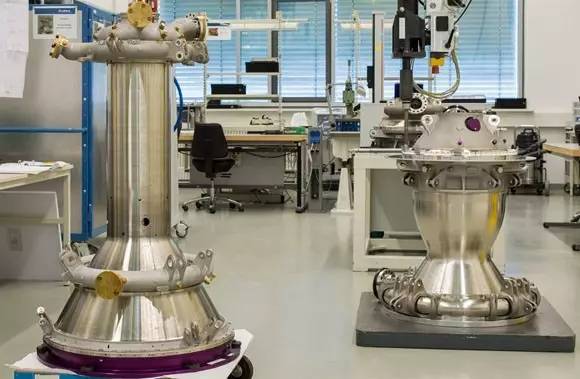The latest generation of the Ariane 6 - Ariane space rocket will be put into use in 2020. The new rocket engine adds payload capacity and flexibility to high reliability and is suitable for a variety of tasks.
Some parts of the Vinci engine are produced in Ottobrunn, Germany, and power the Ariane 6 rocket. Once the rocket uses its solid fuel booster to escape the Earth's gravitational field, the Vinci engine will take over the subsequent thrust. The design of the engine is both energy efficient and lightweight, and plays an important role in ensuring optimal space advancement.

Photo: Vinci Engine Rocket Propulsion Room, Source: German Aerospace Center
Both additive manufacturing and powder metallurgy technologies are used in the manufacturing of parts in Vinci engines, and engine designers believe that 3D printing can reduce costs and optimize machining efficiency. According to Ariane's Denis Regenbrecht, 3D printing is especially suitable for parts production involving complex structures, which not only eliminates expensive manufacturing costs, but also greatly reduces other costs by simplifying the engine structure.
Such cost-effectiveness is crucial for the production of all space technologies, and the European launch system is facing increasing competition in the global market. According to Denis Regenbrecht, “competition will intensify the pressure to control costs in the future, Ariane 6 It is a positive response to this competitive pressure, as its launch costs will be about half that of Ariane 5."
The main body of the Vinci engine will be produced by the Ariane Group at the Vernon plant in France, while the combustion chamber is produced in Germany. Vinci uses low-temperature hydrogen (LH2: ? liquid hydrogen at minus 253 °C) as a fuel after the expander cycle, and low-temperature oxygen (LOX ? liquid oxygen at minus 180 °) as an oxidant. First, the fuel flows around the combustion chamber, cools and evaporates. The gas produced by this process is used to drive a turbo pump, and the oxidant and fuel enter the combustion chamber where they are combusted with additional oxidant.
According to reports, Ariane 5 is one of the most reliable launch vehicles to date in its 79 successful launches. The Ariane 6 engine has been carefully tested to ensure payload and safe transport to space, and further testing is being carried out at the Deutsches Zentrum für Luft- und Raumfahrt (DLR) Space Propulsion Institute.
The German-based Aerospace Center (DLR), based in Cologne, is the German agency responsible for researching aerospace and planning and implementing space missions. It is the German national aerospace and aerospace research center. Its extensive research and development work is included in national and international cooperation projects. .
3D Science Valley REVIEW
The engine manufacturing contractor for the Ariane 6 rocket is mainly GKN. In June 2017, GKN Aerospace announced the availability of the advanced Ariane 6 rocket nozzle (SWAN) to Airbus and Safran in France. With a diameter of 2.5 meters, the nozzles are manufactured with innovative technology for higher performance, shorter lead times and lower costs. Processing of critical structural components through laser welding and laser energy deposition processes reduces the number of parts in the nozzle by 90%, from approximately 1,000 parts to approximately 100 parts. And reduce the cost by 40% and reduce the delivery time by 30%.
The GKN Aerospace Division will provide five complex subsystems for each Ariane 6 rocket, including the turbine components of the engine and the components in the hydrogen and oxygen fuel system power plants.
In fact, the space business unit of GKN Aerospace, Trollhättan, Sweden, has been active in the Ariane program since its inception in 1974, and has supplied more than 1,000 combustion chambers and nozzles and more than 250 turbines to the Ariane rocket. This manufacturing plant is advancing with the times and is now the center of excellence for turbines and metal nozzles in Europe. Through the cooperation with academia to carry out industrial production exploration, it is at every stage of the initial research and development of additive manufacturing. make a contribution.
The GKN Trollh?tten Additive Manufacturing Excellence Center's electron beam wire melting welding technology is mainly used to manufacture large GKN aero engine parts and aerospace parts. The powder-feeding laser powder deposition technology of the GKN Trollh?tten Center is mainly used for the repair of titanium alloy and nickel-based alloy parts.
(Editor)
Kitchen Cabinet,Kitchen Counter For Dinning,Kitchen Cabinet For Home,Kitchen Cupboard For Home
Foshan Artcheer Home Solution Corporation Limited. , https://www.artcheer88.com